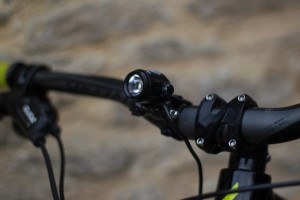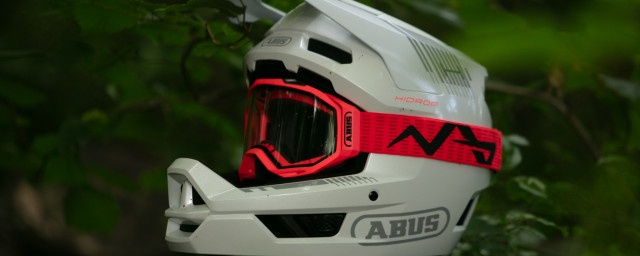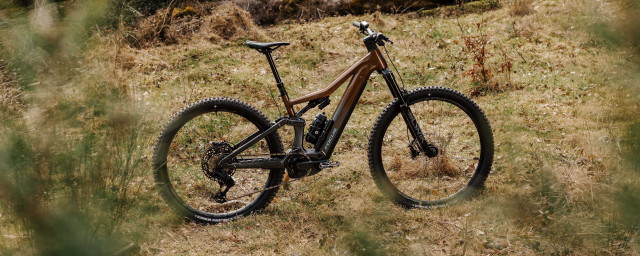USE Exposure’s Zenith MK2 combines a high lumen count and useful battery life with a beautiful build quality and beam pattern. As expected from Exposure, it comes with a selection of neat features making it one of the best mountain bike lights you can buy. However, it is at the expensive end of the scale.
- 9 top tips to make the most of the off-road night riding season
- USE Exposure Sixpack MK12 SYNC MK4 front light review
- Niterider Lumina 1100 Boost Front Light
USE Exposure Zenith MK2 - Technical details
The second iteration of the Zenith comes after calls for an upgrade and, now, it packs 2100 lumens with a wider beam, too. This new version also comes with useful tech that’ll please even the most seasoned night riders.
Encased within an anodised 6063 aluminium body are three white XPL2(W3) bulbs. It’s also home to a 5,000 mAH Li-Ion battery that offers up to 18 hours of run time, depending on the settings and outputs chosen. It then takes five hours to charge.
As for measurements, this thing is pretty small, measuring 120mm in length and 41mm at its largest diameter. It weighed 150g on my scale - spot on with the quoted figure.
The Zenith MK2 comes with a range of features that make it an enjoyable bit of kit to live with. First and foremost, it comes with nine programs that can be scrolled by holding down the rear-facing stainless steel button. These programs offer a choice of run times, which in turn, extend on decrease the light’s battery life depending on the length of your ride.
Then, there’s TAP, which makes use of accelerometers inside of the light to detect when it’s knocked or tapped by your hand. This then scrolls through the output settings.
Next up, the Zenith MK2 can be used as a power bank thanks to Exposure’s SPT+ feature and it also uses a single LED to show battery level with a simple traffic light system, red being low and green being full. Finally, the light’s output is automatically tapered in instances where it’s overheating, offering vital protection.
USE Exposure Zenith MK2 - Performance
The Zenith MK2 isn’t the most simple to use if you’re looking to squeeze the absolute most out of it because there’s a single button to access the raft of programs and adjustability. To the uninitiated, spending some time on the brand’s website and watching the super useful instructional videos uncovers all of the secrets behind this light-emitting powerhouse.
Once well acquainted, the light’s settings are easy to navigate and it’s only made easier thanks to the handy chart etched into the light’s body. Here, you’ll find each program and the run times they offer. This is also where you’ll find adjustments to the TAP feature.
With the light being simple in build, I first thought that TAP was a bit of a gimmick but, in use, it makes life with the Zenith MK2 quicker. It just takes a deliberate push to scroll through the output settings and never during my time with the light has it adjusted itself. Though, if this were to happen it can be shifted into a firmer, or less sensitive setting to avoid this.
While the light has a button that’s easy enough to reach, tapping the light is a near-thoughtless task. However, there have been a couple of instances where the Zenith hasn’t changed settings after being struck, so the button is a much more reliable alternative in case things go wrong.
As for the all-important beam, Exposure’s efforts in shaping the Zenith’s beam demand applause. The centre makes up a large hotspot that throws the light far down the trail. Away from this centre portion, the light is dimmer but it tapers towards its edge smoothly, illuminating nasty trail features towards the outer of my vision. Even though the Zenith’s output pierces deep into the trail, it’s impressively wide for such a small unit, as it combines its long throw with the usefulness of a flood light, increasing the performance of any bar-mounted lights.
The colour of the light is close to daylight, though it’s a touch cooler. Though, there’s nothing to complain about here.
It’s impossible to know where the Zenith is battery-wise when used as a helmet light. Though, that's an issue with many helmet lights. As the Zenith burns through its battery life, it gives you an array of flashes as it moves from full to mid and mid to low. This is an incredibly handy visual aid indicating its battery level without having to remove the light, or helmet. This could be distracting mid-descent, however.
I’ve primarily used the Zenith in program 1, it’s brightest and when kept in its highest output setting, I’ve wrung out a little more than an hour’s use. Given that Exposure says that the shortest run time is one hour, this is excellent news.
USE Exposure Zenith MK2 - Verdict
It doesn’t take much of a scroll through your favourite online retailer to find learn the Zenith MK2 is one of the pricier lights. For example, there’s Gloworm’s X2 Adventure Lightset that’ll cost £240. This one offers two hours of run time but can only be used with a separate external battery.
There’s also Knog’s PWR Mountain Kit at £220. This one follows a modular design but also utilises an external battery pack. However, it is a higher-capacity battery and blasts out 2,000 lumens.
If you’re after a top-quality helmet light with a faultless beam pattern that chucks light far down the trail while confidently illuminating your peripherals, it’s tough to knock the USE Exposure Zenith MK2. It’s certainly expensive and takes a bit of learning to make the most of every feature but you get what you pay for in performance and build.















Add comment